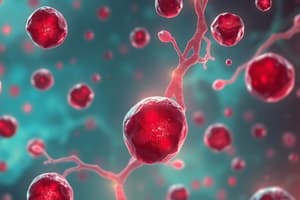Podcast
Questions and Answers
What is hemolytic anemia characterized by?
What is hemolytic anemia characterized by?
- The premature production of red blood cells
- The abnormal shape of white blood cells
- The excessive production of platelets
- The premature destruction of red blood cells (correct)
What is hereditary spherocytosis?
What is hereditary spherocytosis?
- A type of mechanical trauma causing RBC destruction
- A type of infection causing RBC destruction
- A genetic defect causing abnormal RBC shape and membrane structure (correct)
- A type of autoimmune hemolytic anemia
What is paroxysmal nocturnal hemoglobinuria (PNH)?
What is paroxysmal nocturnal hemoglobinuria (PNH)?
- A type of infection causing RBC destruction
- A type of mechanical trauma causing RBC destruction
- A type of autoimmune hemolytic anemia
- An acquired defect causing abnormal RBC membrane protein (correct)
What is the main cause of autoimmune hemolytic anemia (AIHA)?
What is the main cause of autoimmune hemolytic anemia (AIHA)?
What is a symptom of hemolytic anemia?
What is a symptom of hemolytic anemia?
What is a laboratory finding of hemolytic anemia?
What is a laboratory finding of hemolytic anemia?
What is a diagnostic test for hemolytic anemia?
What is a diagnostic test for hemolytic anemia?
What is a treatment option for hemolytic anemia?
What is a treatment option for hemolytic anemia?
Flashcards are hidden until you start studying
Study Notes
Definition and Classification
- Hemolytic anemia is a type of anemia characterized by the premature destruction of red blood cells (RBCs)
- Classified into two main categories:
- Intrinsic hemolytic anemia: defects within the RBCs themselves
- Extrinsic hemolytic anemia: destruction of RBCs due to external factors
Causes of Intrinsic Hemolytic Anemia
- Genetic defects:
- Hereditary spherocytosis: abnormal RBC shape and membrane structure
- Hereditary elliptocytosis: abnormal RBC shape
- Pyruvate kinase deficiency: enzyme deficiency affecting RBC energy metabolism
- Acquired defects:
- Paroxysmal nocturnal hemoglobinuria (PNH): abnormal RBC membrane protein
- G6PD deficiency: enzyme deficiency affecting RBC antioxidant defenses
Causes of Extrinsic Hemolytic Anemia
- Autoimmune hemolytic anemia (AIHA): production of antibodies against RBCs
- Warm AIHA: IgG antibodies bind to RBCs at body temperature
- Cold AIHA: IgM antibodies bind to RBCs at low temperatures
- Infections:
- Malaria: parasite infection and destruction of RBCs
- Babesiosis: parasite infection and destruction of RBCs
- Mechanical trauma:
- Microangiopathic hemolytic anemia: RBC destruction due to abnormal blood flow and small vessel obstruction
- Toxicity:
- Snake venom: hemolytic toxins in some snake venoms
- Chemicals: certain chemicals, such as lead, can cause RBC destruction
Clinical Features and Diagnosis
- Symptoms: fatigue, weakness, pale skin, jaundice, dark urine
- Laboratory findings:
- Anemia: low RBC count, hemoglobin, and hematocrit
- Reticulocytosis: increased immature RBCs
- Bilirubinemia: increased bilirubin levels
- Direct Coombs' test: detects antibodies bound to RBCs
- Diagnostic tests:
- Blood smear: examination of RBC morphology
- Bone marrow biopsy: examination of bone marrow cellularity and morphology
Treatment and Management
- Treatment depends on the underlying cause
- Supportive care:
- Blood transfusions
- Folic acid supplementation
- Immunotherapy:
- Corticosteroids
- Rituximab (for AIHA)
- Splenectomy: surgical removal of the spleen (for hereditary spherocytosis and other forms of hemolytic anemia)
Definition and Classification
- Hemolytic anemia is characterized by the premature destruction of red blood cells (RBCs)
- Classified into two main categories: intrinsic and extrinsic hemolytic anemia
Intrinsic Hemolytic Anemia
- Caused by genetic defects, such as:
- Hereditary spherocytosis: abnormal RBC shape and membrane structure
- Hereditary elliptocytosis: abnormal RBC shape
- Pyruvate kinase deficiency: enzyme deficiency affecting RBC energy metabolism
- Caused by acquired defects, such as:
- Paroxysmal nocturnal hemoglobinuria (PNH): abnormal RBC membrane protein
- G6PD deficiency: enzyme deficiency affecting RBC antioxidant defenses
Extrinsic Hemolytic Anemia
- Caused by autoimmune hemolytic anemia (AIHA), including:
- Warm AIHA: IgG antibodies bind to RBCs at body temperature
- Cold AIHA: IgM antibodies bind to RBCs at low temperatures
- Caused by infections, such as:
- Malaria: parasite infection and destruction of RBCs
- Babesiosis: parasite infection and destruction of RBCs
- Caused by mechanical trauma, such as:
- Microangiopathic hemolytic anemia: RBC destruction due to abnormal blood flow and small vessel obstruction
- Caused by toxicity, such as:
- Snake venom: hemolytic toxins in some snake venoms
- Chemicals: certain chemicals, such as lead, can cause RBC destruction
Clinical Features and Diagnosis
- Symptoms: fatigue, weakness, pale skin, jaundice, and dark urine
- Laboratory findings, including:
- Anemia: low RBC count, hemoglobin, and hematocrit
- Reticulocytosis: increased immature RBCs
- Bilirubinemia: increased bilirubin levels
- Direct Coombs' test: detects antibodies bound to RBCs
- Diagnostic tests, including:
- Blood smear: examination of RBC morphology
- Bone marrow biopsy: examination of bone marrow cellularity and morphology
Treatment and Management
- Treatment depends on the underlying cause
- Supportive care, including:
- Blood transfusions
- Folic acid supplementation
- Immunotherapy, including:
- Corticosteroids
- Rituximab (for AIHA)
- Surgical intervention, including:
- Splenectomy: surgical removal of the spleen (for hereditary spherocytosis and other forms of hemolytic anemia)
Studying That Suits You
Use AI to generate personalized quizzes and flashcards to suit your learning preferences.




